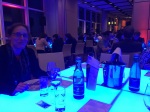One final push…we were back on paleoclimate again first thing, more data than models though a bit of a mix of both. Just as the session ended and I started to think about going in search of lunch, lunch arrived in the form of sandwiches for the Atmospheric Sciences Division meeting. I usually attend the Climate Division meeting so thought it might be interesting to see if AS would have a different style. It didn’t really (even the sandwich was the same), and the most interesting points of discussion were rather similar – mostly, how to cope with the meeting outgrowing the available space. There’s no great solution and I am coming round to the idea that a slight discouragement towards throwing in too many abstracts might be the least-worst approach. There are of course ways round the one-abstract-per-first-author for anyone sufficiently motivated (like jules and I might be) but people who chuck in virtual duplicates to several sessions might be dissuaded which would be a good thing in terms of conference quality as well as freeing up space. I’m not sure it will make much difference overall though as surely there can’t be all that many of these cases. Some audience members also made the case for more remote participation and I don’t think the EGU can continue to resist this indefinitely. Attending in person brings greater benefits, but also costs, and allowing people to participate without the massive investment of time and money involved in travel could surely only be a good thing.
The afternoon sessions contained some advanced and high resolution modelling – a mix of future plans and existing results. Bjorn Stevens gave a well-received talk extolling the benefits of 1km resolution modelling. Mind you a bunch of high-resolution modellers is perhaps not the toughest crowd for that topic! There were some very truthy images of modelled clouds looking like reality. A particular goal of the highest resolution modelling is to resolve tropical storms and some of our past Japanese colleagues had some impressive results here too.
Previously the Friday afternoon slot has usually been a bit of a graveyard with lots of conference-goers leaving early for flights home, but now the schedule is so full there was even a busy poster session in the evening, including more of both the paleo and advanced numerical modelling. We hung around for the start of the convenors’ party but left quite early.

And now for the final score: jules says she had 9 free meals during the week, which were much higher quality than previously (so that’s where the EGU budget disappears to). As for myself, I attended 7 of the 3 meals to which I was actually invited. It seemed a particularly good week this time, perhaps partly due to our long absence. We last came 2 years ago when we were so ill and tired we only attended a fraction of the week, so this time there was rather a lot of new stuff. Jules was also involved in three sessions and we had a total of 4 presentations between us, which kept us busy across a wide range of topics. There was also an element of escapism for us in getting away from home for a bit, which we can now return to feeling (I hope) somewhat rejuvenated.
As for Day 6, we started off with a lovely sunny jog along the Donau Insel, and I’m pleased to report that my legs are now just about working properly after the marathon.

Some gentle sightseeing in town (see Belvedere above) was rounded off by a fabulous concert from the Vienna Philharmonic. I always check their schedule when we are at the EGU – more often than not they are either absent or sold out but this time we got prime seats for a concert including Elgar’s Cello Concerto by Sol Gabetta. We were so worn out by this stage that we forgot to check the venue and went to the wrong place, but fortunately the right place is only a short walk away. jules and I were amused to see a prominent EGU committee member taking photos in the concert hall just after the announcer had clearly forbidden such behaviour  It looked rather like this:
It looked rather like this:
 It looked rather like this:
It looked rather like this:










